Seeing Shorebirds: From Peeps to White Pelicans
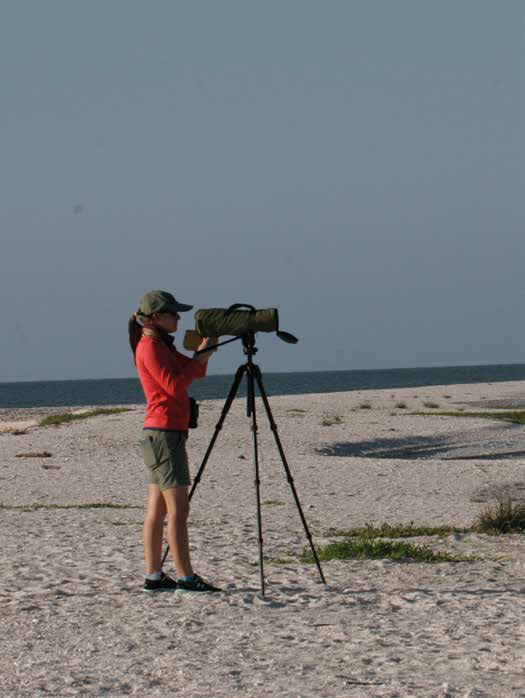 Rookery Bay National Estuarine Research Reserve was designated in 1978 and named for the bay where thousands of wading birds roost and nest on certain mangrove islands, and a lot of other birds also rely on this area for survival. Reserve staff and volunteers keep tabs on these bird populations as an indicator of estuarine health.
Rookery Bay National Estuarine Research Reserve was designated in 1978 and named for the bay where thousands of wading birds roost and nest on certain mangrove islands, and a lot of other birds also rely on this area for survival. Reserve staff and volunteers keep tabs on these bird populations as an indicator of estuarine health.
I recently had the pleasure of joining our shorebird monitoring intern Alli, volunteer captain Larry and another staff member on the monthly shorebird survey. We got an early start from the Ten Thousand Islands field station, near Goodland, so that we could take advantage of the tide and get back by lunch.
Our first destination was the Second Chance Critical Wildlife Area just south of Cape Romano, this is one of the sand bars in our area that is posted and closed every spring and summer to afford thousands of beach-nesting birds the best opportunity to reproduce with the least amount of disturbance from human activity. These areas are also important for wintering shorebirds.
High tide is the best time to get close to these shallow shoals, and it is also the best time to count birds. Thousands of shorebirds feed on sand bars and mudflats exposed at low tide, but a thigh tide when their buffet is closed, they rest in concentrated flocks on patches of dry sand.
Alli set up her scope to get a closer look at the birds on the other side of the sand bar. While we kept a safe distance from the resting flocks, we were greeted by a pair of Wilson’s plovers whose warning calls indicated that we were entering their territory. These year-round residents would soon be laying eggs in shallow scrapes they make in the sand.
Nearby, a small, mixed flock was feeding in a frenzy, running in and out as the tide lapped the shore. Sanderlings and ruddy turn stones were gobbling up what may have been a cache of horseshoe crab eggs, an important energy source for migrating birds all along the eastern seaboard and Gulf of Mexico.
Sanderlings and ruddy turn stones both spend winters here, but will soon be departing for their summer breeding grounds in the high arctic-more than 3,000miles away!
 As Alli recorded her sightings she was excited to see some birds with colored bands and flags on their legs. The high-powered scope enables her to read the unique letter and number combination that is specific to each bird in a research study. She will later track down details about these birds, such as when and where they were banded, and her report about their current location will help provide that researcher with important clues to the birds’ migration patterns and life history.
As Alli recorded her sightings she was excited to see some birds with colored bands and flags on their legs. The high-powered scope enables her to read the unique letter and number combination that is specific to each bird in a research study. She will later track down details about these birds, such as when and where they were banded, and her report about their current location will help provide that researcher with important clues to the birds’ migration patterns and life history.
Our next stop was Morgan Bay on the west side of Cape Romano. As we approached Morgan Pass, I could see something big and white covering the mudflat on the inside of the bay. This out-of-place snow drift was actually a flock of white pelicans. Their large size and sheer number was almost blinding in the bright sun. Alli’s scope confirmed that the flock numbered over 120 individuals.
With a wingspan of 114 inches, white pelicans are the second largest birds in North America: only the California condor is larger. Seeing these majestic birds is a special treat as this is another species that breeds in central and northern North America each summer.
The pelicans excited me, but Alli was focused on counting the seemingly endless mass of tiny brown shorebirds, collectively referred to as “peeps,” that shared the flat with the white giants. Here we saw western sandpipers, dunlin, short-billed dowitchers, red knots and three species of plover: semi-palmated, Wilson’s and piping plovers, which are listed as threatened in Florida but endangered in other parts of the U.S.
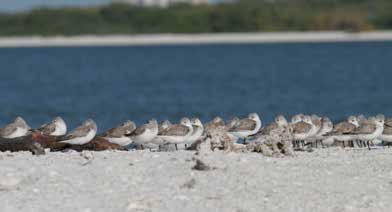 Alli was very excited when she spotted two piping plovers with banded legs that she had seen previously. “Agatha” and “Finch” were banded in 2015 at Edwin B. Forsythe National Wildlife Refuge in New Jersey. She also spotted T4N, which is a sanderling that was banded at a migration stopover site in Delaware in spring 2015. This was the first time it’s been seen outside of Delaware – now we know where it spends the winter! KP5 is a red knot with a very faded band. It was banded in 2007 on Sanibel and has been seen in Florida almost yearly since then. 65T was banded in South Carolina in 2012 and appears to winter in SW Florida. It has been seen in Massachusetts and New Jersey during migration.In all, Alli counted 4,567 individual birds of 17 different species.
Alli was very excited when she spotted two piping plovers with banded legs that she had seen previously. “Agatha” and “Finch” were banded in 2015 at Edwin B. Forsythe National Wildlife Refuge in New Jersey. She also spotted T4N, which is a sanderling that was banded at a migration stopover site in Delaware in spring 2015. This was the first time it’s been seen outside of Delaware – now we know where it spends the winter! KP5 is a red knot with a very faded band. It was banded in 2007 on Sanibel and has been seen in Florida almost yearly since then. 65T was banded in South Carolina in 2012 and appears to winter in SW Florida. It has been seen in Massachusetts and New Jersey during migration.In all, Alli counted 4,567 individual birds of 17 different species.
Like a lot of our human snowbirds, these birds are a long way from home. They need every ounce of energy they can save over winter to not only make the return trip to their northern breeding grounds, but arrive with enough energy reserves to lay eggs and raise a family.
If you enjoy seeing these birds along our shores, always respect posted areas and keep your distance to avoid flushing them unnecessarily. It’snot just polite, it’s a matter of survival.
Programs Tours and Events at Rookery Bay Reserve
Rookery Bay Environmental Learning Center is open 9 a.m. to 4 p.m. Monday through Saturday, and offers a two-story visitor center, art gallery, gift shop and nature trail with viewing platform. Themed naturalist programs offered daily on topics such as manatees, sharks, sea turtles, marine life touch tank and more. Admission is $5 for adults, $3 for kids 6 – 12, and free for kids under six and Friends of Rookery Bay members. Located at 300 Tower Road, one mile south of the intersection of US 41 and Collier Boulevard. Learn more, or register for events, at rookerybay.org.
 Guided Boat and Kayak Tours
Guided Boat and Kayak Tours
Two-hour guided kayak tours let you explore backwater bays and mangrove tunnels while learning about your surroundings from an experienced guide and naturalist. Tours provide opportunities to see wildlife such as wading birds, osprey, fish and dolphins. Tours include free admission to the Environmental Learning Center on day of trip and proceeds support the non-profit Friends of Rookery Bay, Inc. Kayak and boat tours are offered Tuesdays through Fridays from November through April.
April 3 – 7, 8:30 a.m. – 4:30 p.m.
 Drawing Animals in Nature (Graphite)
Drawing Animals in Nature (Graphite)
Join our Artist in Residence, Lee Hammond, and learn how to realistically draw animals in nature in graphite. This class is based on the “Hammond Blended Pencil Technique” from Lee Hammond’s best-selling books. In 5 days, you will learn everything you need to draw anything proficiently in pencil. Hammond has been a professional artist and art instructor for more than 30 years. She has published more than 35 art instruction books. Supplies are not included. Cost is $395.
April 8, 8 a.m. – 12 p.m.
Birding Basics
Enjoy this fun and informative class designed to help you identify birds around you. Oriented toward the beginning birder, the classroom session explores how to use birds’ plumage, shape, behavior and habitat to recognize various species. It also covers the effective use of binoculars and field guides. During the second part of the class you will learn more tricks of the trade during a field trip to a nearby park where you can enjoy practicing new skills. Cost is $40.
April 10, 9:30 a.m. – 12:30 p.m.
 Essentials of Digital Photography Workshop
Essentials of Digital Photography Workshop
Get the best pictures possible and truly understand your digital camera’s features. You will learn how to use your camera’s shutter, aperture, ISO control and the drive modes to create images with impact and creativity. No previous camera or photography experience is necessary, just a desire to learn. Sonny Saunders has over 35 years of experience in photography and instruction and is renowned for his ability to communicate to a wide variety of students. Cost is $55.
April 12, 9 a.m. – 1:00 p.m.
Open Studio Class with Artist-in-Residence Lee Hammond
Open studio classes are for new or existing students to work independently on their artwork. Bring your art projects and allow Lee Hammond to show you how to improve and complete your drawings (graphite or colored pencil only- no pastel) or paintings (watercolor or acrylic only, no oils). Supplies are not included. Cost is $45.
April 18, 12 – 1 p.m.
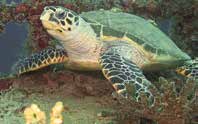 Lunch & Learn: Dr. Jim Fourqurean – Green turtles graze down Bermudian seagrass meadows on the move to South Florida!
Lunch & Learn: Dr. Jim Fourqurean – Green turtles graze down Bermudian seagrass meadows on the move to South Florida!
Green turtle conservation measures over the last few decades have been successful in increasing the number of bay green sea turtles hatching and entering the ocean. But, the world these turtles will grow up in is very different than the one that existed even a century ago. Young turtles eventually settle in developmental habits in shallow coastal areas and their diet switches to seagrasses as they mature for 10-20 years before they are old enough to return to their breeding grounds. One of these developmental areas is in Bermuda, where the seagrasses that support these young turtles are in rapid decline, driven by the grazing of the developing turtles. And some of the Bermudian turtles return to the home of their parents here in south Florida, where they graze on our seagrasses. Lecture is $15, or $10 for Friends of Rookery Bay members, includes lunch.
April 22, 9 a.m. – 4 p.m.
Earth Day BOGO
In celebration of Earth Day, the Rookery Bay Environmental Learning Center offers “buy one, get one free admission.” Higher price prevails. Cannot be combined with other offers. Must pay at door.

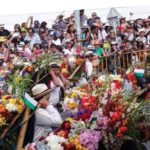
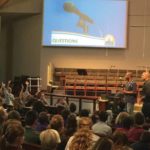
Leave a Reply
Want to join the discussion?Feel free to contribute!